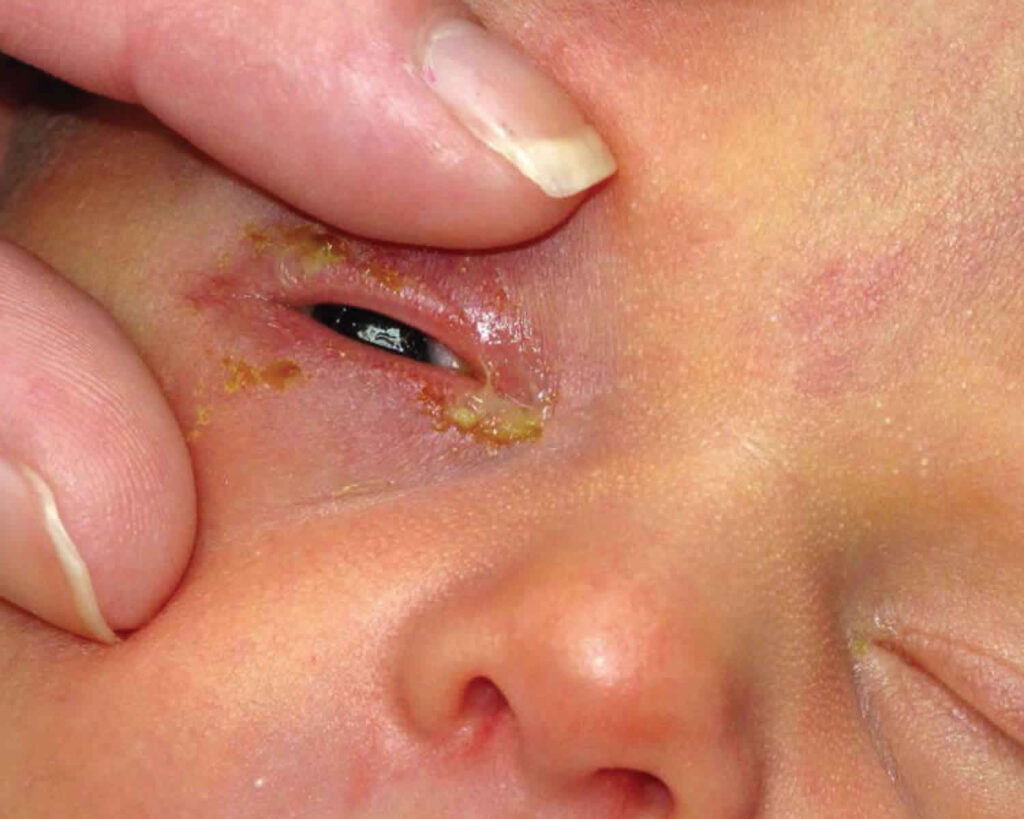Neonatal ophthalmia, also known as ophthalmia neonatorum, is an acute conjunctival infection occurring within the first 28 days of life. The condition is predominantly caused by Neisseria gonorrhoeae, Chlamydia trachomatis, and less frequently, herpes simplex virus and bacterial flora from the birth canal. Without prompt intervention, ophthalmia neonatorum can lead to corneal ulceration, blindness, and systemic infections.

Pathogens and Routes of Transmission
The primary route of transmission is vertical, from mother to child during vaginal delivery. The risk is significantly heightened in untreated or undiagnosed maternal sexually transmitted infections (STIs).
Common Pathogens and Their Characteristics:
| Pathogen | Onset Time Post-Birth | Clinical Features |
|---|---|---|
| Neisseria gonorrhoeae | 2–5 days | Profuse purulent discharge, edema |
| Chlamydia trachomatis | 5–14 days | Mucopurulent discharge, less edema |
| Herpes simplex virus | 6–14 days | Vesicular lesions, systemic signs |
| Common bacteria (e.g., Staph aureus) | 2–5 days | Mild discharge, less severe course |
Universal Prophylaxis: A Global Standard for Eye Protection
Ocular Prophylaxis Immediately After Birth
Routine eye prophylaxis is mandated or recommended in many countries as a universal preventative measure against gonococcal ophthalmia.
Recommended agents:
- Erythromycin 0.5% ophthalmic ointment – most widely used and currently the only FDA-approved agent in the United States.
- Tetracycline 1% ointment – alternative where available.
- Povidone-iodine 2.5% solution – effective against a broad spectrum including Chlamydia and Neisseria.
- Silver nitrate 1% – historically used, now largely discontinued due to chemical conjunctivitis.
Application Protocol:
- Apply a 1-cm ribbon of ointment to each lower conjunctival sac.
- Administer within 1 hour of birth for maximum efficacy.
Prenatal Maternal Screening and STI Management
Targeted STI Screening in Pregnant Women
We emphasize early and repeated screening for Neisseria gonorrhoeae and Chlamydia trachomatis in pregnant individuals, particularly those with high-risk sexual behaviors or limited prenatal care access.
Screening timeline:
- Initial prenatal visit
- Third trimester for high-risk individuals
Positive maternal tests must be followed with appropriate antibiotic treatment and test-of-cure to reduce the risk of transmission.
Risk-Based vs Universal Prophylaxis: Policy Considerations
While many developed countries implement universal prophylaxis, others adopt a risk-based approach, especially in regions with low STI prevalence and high prenatal screening coverage.
Risk-Based Approach Includes:
- Selective prophylaxis for infants of mothers with:
- Untreated or untested STIs
- Limited prenatal care
- Evidence of genital infection at delivery
However, we advocate that universal prophylaxis remains the most reliable strategy, especially where STI surveillance is inconsistent.
Clinical Assessment and Management of Suspected Cases
Signs Suggestive of Ophthalmia Neonatorum
- Redness and swelling of eyelids
- Conjunctival injection
- Profuse discharge (purulent or mucopurulent)
- Corneal involvement or ulceration in severe cases
Diagnostic Approach
- Gram stain and culture for N. gonorrhoeae
- Polymerase Chain Reaction (PCR) testing for C. trachomatis
- Viral cultures if HSV suspected
- Evaluate for systemic infection, particularly in gonococcal cases
Treatment Protocols Based on Etiology
| Pathogen | Treatment |
|---|---|
| N. gonorrhoeae | Ceftriaxone 25–50 mg/kg IM/IV (max 125 mg) single dose |
| C. trachomatis | Erythromycin oral 50 mg/kg/day for 14 days |
| HSV | Acyclovir IV + ophthalmologic consultation |
| Non-specific bacterial | Topical antibiotic drops or ointment (e.g., erythromycin) |
Systemic antibiotics are mandatory for N. gonorrhoeae and C. trachomatis due to potential dissemination.
Emerging Alternatives and Future Considerations
Vaccine Development
Vaccines against Chlamydia trachomatis are in preclinical and early clinical development stages, offering hope for future maternal immunization strategies to prevent transmission.
Antimicrobial Resistance Concerns
There is growing concern over resistance in N. gonorrhoeae to ceftriaxone and macrolides. Monitoring resistance patterns and ensuring appropriate antibiotic stewardship are essential.
Summary Table: Key Prevention Recommendations
| Strategy | Action |
|---|---|
| Maternal STI screening | Early in pregnancy; repeat in third trimester if high risk |
| Maternal STI treatment | Immediate antibiotics with follow-up testing |
| Neonatal prophylaxis | Universal administration of erythromycin ointment |
| Diagnostic evaluation | Based on clinical signs; culture and PCR |
| Targeted treatment | Based on identified pathogen |
| Public health policy | Encourage universal protocols, especially in high-burden settings |
The prevention of neonatal ophthalmia demands a comprehensive strategy encompassing maternal screening, prompt treatment of STIs, and universal neonatal ocular prophylaxis. Such an integrated approach remains the most effective method to reduce the global burden of neonatal conjunctivitis and its devastating complications. As we await the development of preventative vaccines and improved diagnostic modalities, adherence to current guidelines remains vital to protecting neonatal vision and health.